ActiNav System Automates Flexible Machine Loading
Universal Robots’ ActiNav software provides a simple, easy-to-deploy solution for bin picking automation in applications with only a single part type to pick.
Share



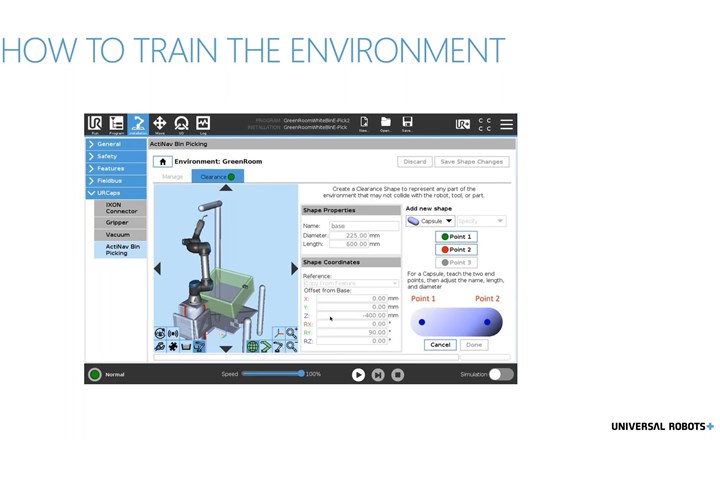
ActiNav’s environmental system allows users to designate particular areas the cobot cannot enter. In this example, the user is training the cobot to avoid collisions with the 3D vision system. All images are screenshots from a webinar UR conducted with MMS on November 12, 2020. UR has since launched an updated webinar, viewable on-demand through the company’s website.
Machine tending traditionally falls afoul of what Silas Neale, channel development manager at Universal Robots (UR), calls the three D’s: “it’s dirty, dangerous and dull.” Few workers enjoy machine tending, and Neale says machine-tending positions face issues in absenteeism, low motivation and high turnover. It is an attractive application for automation — but the inherent randomness of part distribution within a bin makes automation challenging. UR’s ActiNav system uses a 3D sensor and autonomous movement technologies to control for this randomness and bring collaborative automation to machine-tending applications that involve bin picking.
Unstructured Movement
ActiNav is compatible out of the box with UR’s fifth-generation UR5e and UR10e cobots, with the software enabling unstructured bin picking and accurate placement. The autonomous motion module uses the 3D sensor and user-input environmental information to plan collision-free paths for each part, with the adaptive path planning feature eliminating the need for traditional waypoint systems. If the environment changes, Neale says users “simply model the change, and the rest of the program adjusts. This leads to a drastic reduction in project risk.”
Last year, we discussed ActiNav’s Freedrive system of manual movement for training cobots, but the system actually pairs with the autonomous motion module to go a step further: the cobot can independently move its joints through a procedurally generated, collision-free path to reach the pre-place, place and post-place positions taught in Freedrive. For any one trained pick, the cobot will generate and use thousands of pick-and-place solutions as it handles parts in different locations of the bin. This functionality eliminates the need to set up and debug pose-place autonomous solutions, and increases the number of applications in which users can rely on autonomous bin picking.

While the ActiNav system only supports applications with a single trained part in a bin, the system can save programs for up to 100 trained parts. These parts can come in a wide variety of materials and sizes — but must fit within general bounds. As a general rule, Neale says parts the size of “two fists or less” are compatible with ActiNav.
The coding for these technologies is deceptively simple, with UR’s insistence that ActiNav is not robot-agnostic condensing the necessary code. While traditional robotic bin-picking operations with frame pick, waypoints and robot pose placement may include anywhere from 240 to 360 lines of code for one part, coding for ActiNav automatically accounts for the system’s autonomous motion module, Free Spin Pick (which allows tool rotation around the z-axis at a given pick point) functionality and part relative place technology to condense the necessary code to only six lines per part. This enhanced usability, combined with six predefined workflows out of the box, enables users to deploy ActiNav more quickly onto their shop floors. UR says that several of its New England customers were able to move from opening the box to full deployment within two days — reducing deployment time by between three and six weeks.
New Applications, New Compatibilities
To maintain this versatility of pick up and placement, ActiNav only supports applications with a single kind of part per bin. This part can be anything from tubes to cups, cast parts, machined parts, rings or flat parts, so long as the aspect ratio and thickness of the parts enables them to fit in the grippers (or a potential end effector) and the parts have identifiable features for the vision system. Neale says a general rule for suitability is whether a part is smaller than “two fists or less” for volume, with compatible parts typically measuring between 1-inch and 10-inches and weighing below 8 kilograms. The autonomous motion module eases redeployment by saving routines for up to 100 different parts.
ActiNav also supports deeper bin picking, with a medium 3D sensor supporting bins up to 0.5 cubic meter and a large sensor supporting bins up to 1 cubic meter. The 3D sensor uses a CAD-based matching algorithm to determine part positions within a bin — Neale says this simplifies calibration and readjustments. UR adds that the flexibility from the 3D sensor and adaptive path planning results in three times less labor for bin filling.
In the interest of better supporting shops considering ActiNav, UR has developed a quiz on its website to determine if shops’ particular applications are compatible with ActiNav. For further information, UR has launched a nine-part tutorial series on its website and at the Universal Robots Academy YouTube page.
Related Content
Aerospace Shop Thrives with Five-Axis, AI and a New ERP
Within three years, MSP Manufacturing has grown from only having three-axis mills to being five-axis capable with cobots, AI-powered programming and an overhauled ERP. What kind of benefits do these capabilities bring? Find out in our coverage of MSP Manufacturing.
Read More5 Stages of a Closed-Loop CNC Machining Cell
Controlling variability in a closed-loop manufacturing process requires inspection data collected before, during and immediately after machining — and a means to act on that data in real time. Here’s one system that accomplishes this.
Read MoreRevolutionizing Production: How Smart Hydraulics Drive 24/7 Manufacturing Excellence
All World Machinery Supply helps a firearms manufacturer up its game and improve and increase output.
Read MoreAddressing Manufacturing Challenges with Automation
GrayMatter Robotics’ Physical AI robotic cells for manufacturing offer immediate impact and results.
Read MoreRead Next
Avoiding a Failed Automation Integration
New features that simplify robot use have blurred the lines between tasks that shops can automate independently from those that will require the support of an integrator. Here’s what shops should keep in mind to avoid a costly failed integration.
Read MoreAutonomous Bin Picking for CNC Machining Applications
With the launch of a new application kit for collaborative robots, Universal Robots is creating a new option for lights-out machining. But the company may have tapped into a solution for a deeper problem: attracting millennials to the manufacturing workforce.
Read MoreMachine-Tending Automation Gets a Head Start
Making industrial robots more versatile without sacrificing speed or power stretches integration investments and attracts new business.
Read More













-02.jpg;maxWidth=300;quality=90)



.png;maxWidth=300;quality=90)



 (1).png;maxWidth=300;quality=90)




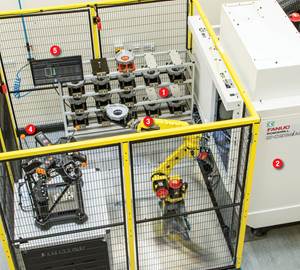


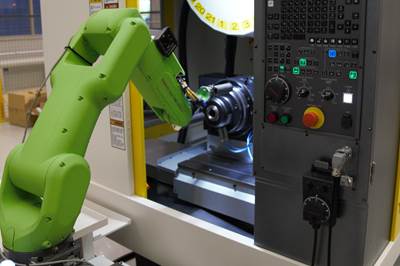
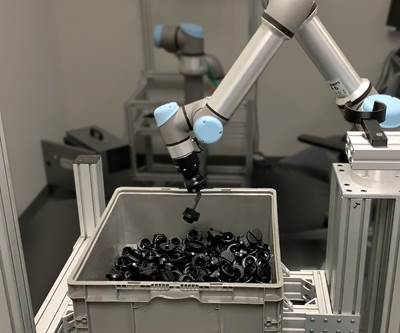
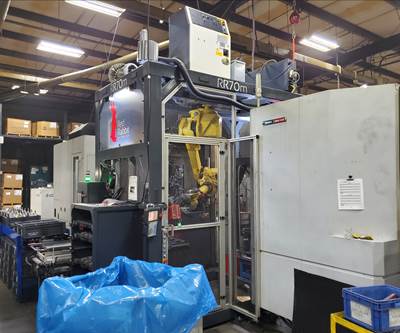
.png;maxWidth=970;quality=90)